Interview with Hisashi Ezura (Visual Effects)
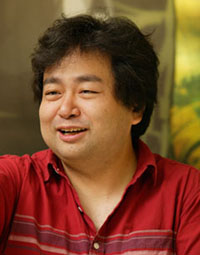 | Hisashi Ezura - Born in 1967, he started working as an animator while he was still a student, collaborating in countless TV series and OVA since then. He's currently the boss of the compositing, filming and visual effects section at Production I.G. His main filmography includes Ghost in the Shell (the groundbreaking full-digital animation segment for the 1997 game edition), Blood: The Last Vampire (2000), Innocence (2004), and of course, Tachigui: The Amazing Lives of the Fast Food Grifters. He is currently working on Mamoru Oshii's new movie, The Sky Crawlers. His technique is commonly described as "Ezura magic". |
Which software did you actually use for the compositing process in Tachigui?
For this movie, I did the whole job using only Adobe After Effects 6.5 and Adobe Photoshop CS. I basically executed three types of compositing according to the different nature of the material that arrived from the other sections. The first consisted in video clips that had already been composited by the 3D team. The second was compositing real-action video clips shot with HDV. And the third one was compositing still pictures taken with digital camera.
As for the third case above, I preprocessed the stills with Photoshop before using After Effects, because Photoshop is more efficient than After Effects for this purpose. Eventually, I did a lot of tablet "drawing." But in all three cases, I used After Effects for compositing. Since each clip was different, I changed the processing procedure according to the content. At the last stage of After Effects processing, I managed to implement grain management, color-correction and focus adjustment to create that unique feel of film.
What was the role of 3D in the film?
This movie has a few sequences that are, so to speak, in traditional 3D animation and not in 'superlivemation'. They are used to introduce a new period or historical turning point, such as WWII at the very opening of the film, jet fighters during the Korean War to introduce the 50s, and B-52 bombing over Vietnam to introduce the 60s.
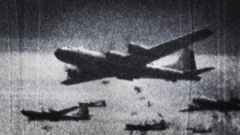
In these turning point sequences, I've added intense visual effects with After Effect to the 3D animation, especially aging processes such as discoloration and damaged film effects. I deformed the films to depict the atmosphere as I thought fit. For example, I modified the WWII sequence to look like a 8mm black-and-white film and the Vietnam War sequence to look like a 16mm color film. When compositing with After Effects, I only used the filters that were included in the software and not the third-party plug-ins.
How time-consuming was the 3D work compared to 'ordinary' 3D animation?
I added several layers of visual effects with After Effects after rendering a 3D movie. That meant a lot of work and time. If I compare the process to a film production, 3D processing could be described as the stage setting and shooting, and the 2D/After Effects process is like working vigorously in the darkroom. Just like how films could be modified into all sorts of styles in the darkroom processes, Tachigui's style, with its unique texture of images, was created through the 2D/After Effects process. This eventually required more toil and time than an 'ordinary' production.
What kinds of compositing processes were necessary to match the three types of shots together seamlessly?
First of all, I added details to the image according to the rendering intention, for instance, film grain and color adjustments. I chose a basic color tone for each of the eight main characters in order to get an integrated feel to each segment, while for the "turning point" sequences, such as WWII and the Vietnam War, I simulated film discoloration or changed the resolution in order to reproduce the atmosphere of each era.
In the final process, I went further to synchronize the texture of the entire film, processing each sequence with a Tachigui special treatment, so that the entire film would come out with a uniformed texture.
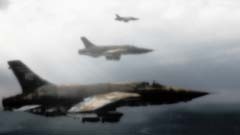
What was the biggest technical challenge you faced during the compositing?
I had to be very flexible according to the different "feeling" required scene by scene, the content of the sequence itself, and the condition of the material. There were so many different cases and different materials! That was challenging. In Tachigui, utilization of visual effects resulted in an extensive variation of textures. That made it difficult to balance each sequence, so I had to be particularly careful to integrate the entire film under a single title.
In addition to that, I had to deal with a great variety of material: 3D, illustrations, stills by digital camera and HDV real-action footage. They all had different textures, so it was essential for the 2D compositing to bring them together, not just as a compilation of different materials, but as a complete stand-alone film. I was an extremely delicate job.
Did you find the process creatively liberating, or did you feel that you were constrained by the original photography?
I was given great freedom. I'd like to point out that a minor After Effects processing of the 3D rendered images and stills was not enough to complete a sequence for Tachigui. The crucial trick was how much 2D compositing I could add to each sequence. So the liberty I had in this job was far greater than in an ordinary Japanese animation production. The amount of ideas that I could put into each sequence virtually decided the quality of the film.
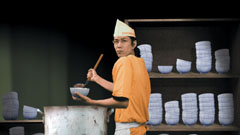
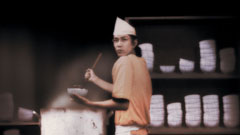
No many Western mainstream directors can afford such use of animation techniques in a similarly experimental way. What do you think of Western animated features? Could a movie like Tachigui have been made outside of Japan?
I am hugely stimulated by animations from the US and Europe. When I encounter pictures and stories that we Japanese could never think of, I definitely feel the difference in values and aesthetics we inherited from our cultural environment.
For instance, the black humor of American animation. We Japanese could never create something like it even if we tried. Translating existing three-dimensional elements, like people or animals, into two-dimensional images, is indeed a process that requires simplification, deformation and stylization. The way this translation process is applied can be radically different between West and Japan in many cases.
But I'd say it's not a technical difference. The differences originated even before the techniques came into play - it's rooted in the original conception. For instance, when I watch Richard Linklater's Waking Life, I strongly feel the difference in the environment we come from. It is something connected to lifestyle and customs, in other words, it is what we see, hear and touch in our everyday life.
Since a lot of manual work is put into animation production, I think the creators' subjectivity plays a big role in an animation. In the images, for example, I see a big difference between the West and Japan in respect to stylization of real forms or utilization of the color palette.
I believe Tachigui has the "atmosphere" that could be described as specific to Japan. Therefore, although it could be possible to make a similar movie outside of Japan technically, it would be impossible to create that unique "Tachigui mood", as it is something coming from a combination of environmental factors that are specific to this country. Just as we could not cleverly recreate American or European "moods" in our animations.
Special thanks to Jasper Sharp
© 2006 MAMORU OSHII, Production I.G / TACHIGUISHI RETSUDEN Committee

![WORK LIST[DETAILS]](/contents/works/design/images/left_title.gif)



 terms of use
terms of use